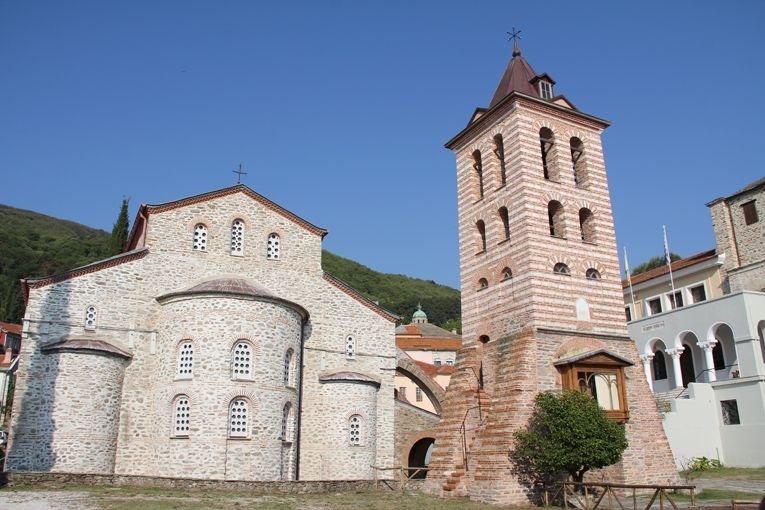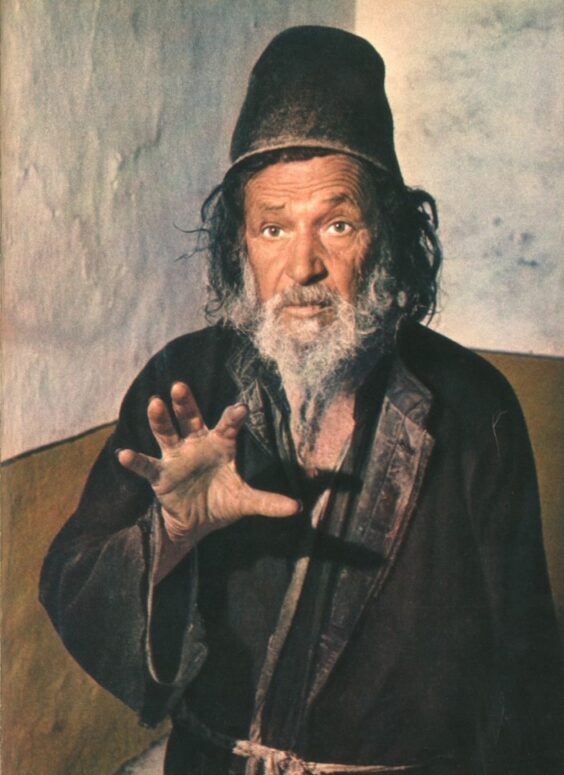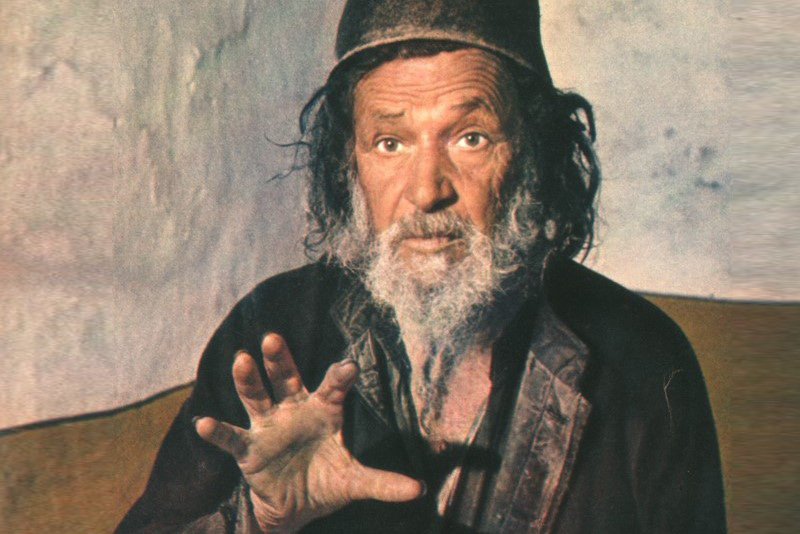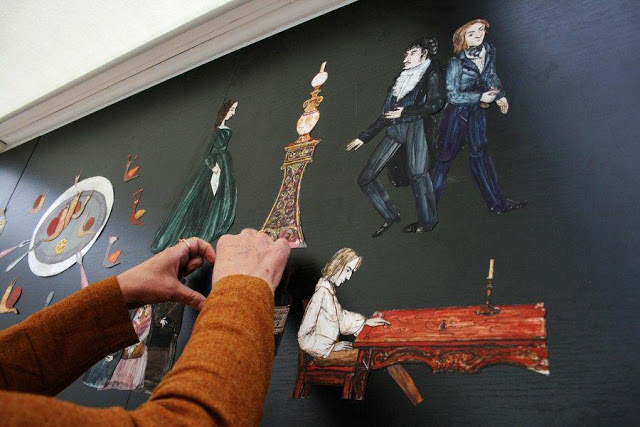
The hermit monks of Mount Athos – called Caveots in Greek – do not reside in any of its monasteries, sketes, or freestanding cells. They have no permanent dwelling and live off the alms, typically from monasteries.
Caveot Costas had a name among the monks and laity of Caries, the administrative capital of Mount Athos. Sometimes, he was seen walking about the city or praying at a liturgy at the Assumption Cathedral, or the Protat. At other times, he engaged himself in different kinds of seemingly irrational acts. The fathers of the church wondered if he was sick or a holy man. They did not even know if he was a monk or one of the laity. – Either way, we remember Caveot Costas for his feat of hermitage and fool for Christ’s sake on Mount Athos.
Costas was born on 10 February 1898 in Kalendzi Village of Epir area. He came to the Holy Mount intending to become a monk. Costas joined Dionysiou Monastery as a novice. After some time at the monastery, he left for Caries to live as a Caveot in an abandoned, half-destroyed cell of the Skete of Saint Andrew the First-Called. Like a monk, he wore a skull cap, a beard and long hair. He donned an old topcoat for a monastic robe.
In winter, he walked around Caries with only a rag on his hips, and in summer, he wore a warm coat. Costas never bathed or washed his clothes; rarely, he hung them out in the rain to rinse off the mud.
Sometimes, Costas visited Gabriel Makavos, a sympathetic hieromonk who fed him and put insecticide powder on his clothes to destroy the numerous fleas and lice in them. Some called Costas the can-man because he always carried an empty can with a wire tied to it for a handle. Costas would approach a cell and sat in front, waiting long hours for the occupant to open the door. As soon as they saw Costas at their door, the brothers came out and put food in his tin. He mixed all the food that he received and sometimes added water before he ate it. When he received the alms, Costas bowed to the occupant of the cell, kissed his had and left.

Sometimes the fathers of Mount Athos saw Costas spend many hours in front of the crypt of the Protat. People who passed him by heard him mutter but could make out the words. They presumed that he was praying for the dead. He was also seen in other places under similar circumstances. Sometimes, he sat in the middle of the road whispering something to himself and not paying attention to what was happening around him. The fathers of Mount Athos were positive that he was reading the Psalter from memory. If someone tried to start a conversation with him, he returned to his senses, did something strange or unusual, and walked away.
Cyr Chrysostom of Saint Andrew’s skete, the would-be bishop of Radostol, wished to find out more about Costas and his way of life. He followed him secretly and heard him serve vespers. He read the liturgical texts from memory without looking into books or using the light. Another time the monastic brothers walked into Costas’ cell when he was away. They waited until he left the territory of the Skete. Then they entered his cell and, to their horror, found him inside. But Costas told them to venerate the four large icons and leave in peace. In his cell, there was not a table, bed or furnace. They could not imagine how he was surviving without a furnace in cold winter weather. After that incident, the future bishop of Radostol treated elder Costas with great respect.
Yet, many did not appreciate his spiritual achievement. Some were mean and disrespectful. One of the residents waited for Costas to come under his window and poured a bucket of cold water onto him. Costas did not move his brow and continued his walk as if nothing had happened.
Being a Fool-for-Christ is an act of outstanding humility. Christ bestows His great love on people like Costas by revealing to them things invisible to others.
Some of Costas’ few possessions included two books, an old edition of the Lenten Triod and a leather-clad book of scriptures. Someone saw the book and wanted to have it so much that he stole it from the elder. Costas met the thief on the road and said, “You took the Scripture. Give it back to me now.” Confused and shamed, the thief returned the book and left convinced that Costas was fully sane and possessed the gift of clear-sightedness. One day, he approached a disciple of Athoniad and told him of a sin that the disciple had committed.
Another day, a young monk dared to question Costas about his past.
“Tell me, Konstantin, are you a monk?”
“Yes,” replied the elder.
“Where did you take your tonsure?”
“At Dionysiou.”
“What name were you given at tonsure?”
“Acace”
“Where do you come from?”
“The islands.”
“Which island?”
“Rodos.”
But when the young monk continued to question the elder, he stopped answering seriously or intelligibly. As a result, it is still unknown if the elder had taken tonsure, or only considered himself as a monk.
Eventually, Elder Costas left Saint Andrew’s Skete and settled in the half-destroyed cell of Saint George, just outside of Caries. The cell had no windows, doors or floor. He moved around walking on the wooden beams, and slept at churches, ticking himself up in an altar corner. Nobody knows how he survived the winter. But, what is impossible for a human is possible for God. He shed on him His blessings and His grace.
When Costas met for the first time Elder Damascene from the cell of Saint Basil as he was walking along a mountain trail, he called him by name, although he had not met him before. In a conversation with Father Damascene, he called himself a descendant from Asia Minor with no name, a theologian and an unacknowledged writer. Only later did it become obvious that the elder had authored two books in theology. The way that Costas introduced himself convinced Father Damascene that he was a man of sound mind and outstanding wisdom and was well versed in matters of faith.

He also shared with Elder Damascene a story that happened before he chose the life of a fool for Christ. On the day when the new Constitutional Charter* of Mount Athos was put on vote at the Protat, he climbed on the bell tower of Protat and sounded the funeral chime. He did so in apprehension that the charter would make the Holy Mount lifeless and unmanageable. He chimed the funeral chime for the death of the old Holy Mount. Back then, he was misunderstood and removed from the bell tower with disgrace. Conversing with Father Damascene, he warned him, “When the traces of the past historical order have become extinguished, and the new order has taken ground, the Holy Mount will have no peace. Monastic dignity will be destroyed or disposed of for the freedom of the state and the bishops to squander its priceless treasures and relics.”
For many years, Elder Costas resided in Mount Athos pursuing his exploit of a fool for Christ. In 1969, powerful Athonites decided, from a worldly perspective, that the presence of a Fool-for-Christ such as Elder Costas was an embarrassment for the administrative centre of Mount Athos, particularly in the eyes of the growing numbers of visitors from the West. They leveraged their authority to have Costas removed from the Holy Mount. At first, they had him expelled to Thessaloniki and hospitalised in a mental clinic. But the doctors found him perfectly sound, so they referred him to a care home. From that point onwards, his whereabouts have been unknown.
The fathers of Mount Athos appreciated his exceptional gifts and mourned his departure. His calmness, humility, peacefulness and inner light made him a jewel of Mount Athos. Alas, those used to thinking in worldly terms are unlikely to appreciate the magnitude of the exploit of a fool for Christ.
Caveot Costas is one of many hundreds of 20th-century hermit monks who resided on Mount Athos. Yet he is one of the very few monks whose way of life and multiple exploits have been documented at least to some degree. We have a lot to learn from his example of humble and ascetic life.
______________________________________
* The Constitutional Charter is the principal document that governs the visible aspects of life on Mount Athos, the relationships among its monasteries, and between Mount Athos and the Greek State. The Charter was enacted in 1926.





I assume this article was composed in Russian or Ukrainian and then translated into English. I noticed several errors in English, the worst being “Caveot”. There is no such word in English. What Russian word was the translator attempting to translate?? Also, Epirus, not Epir. Protaton, not Protat. Karies, not Caries.
Any and all things in the name of the Lord. Amin!
I read about this saint of God, elder Costas, in a book about the Holly Mountain that was translated into Romanian, my country language.
In my country, Romania, I meet few times with a fool for Christ, older Gherontie and even took part of few of his miracles.